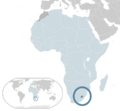Click here to register!
Lesotho Energy Situation
Capital:
Maseru
Region:
Coordinates:
29.0000° S, 28.0000° E
Total Area (km²): It includes a country's total area, including areas under inland bodies of water and some coastal waterways.
30,360
Population: It is based on the de facto definition of population, which counts all residents regardless of legal status or citizenship--except for refugees not permanently settled in the country of asylum, who are generally considered part of the population of their country of origin.
2,305,825 (2022)
Rural Population (% of total population): It refers to people living in rural areas as defined by national statistical offices. It is calculated as the difference between total population and urban population.
70 (2022)
GDP (current US$): It is the sum of gross value added by all resident producers in the economy plus any product taxes and minus any subsidies not included in the value of the products. It is calculated without making deductions for depreciation of fabricated assets or for depletion and degradation of natural resources.
2,236,502,124 (2022)
GDP Per Capita (current US$): It is gross domestic product divided by midyear population
969.94 (2022)
Access to Electricity (% of population): It is the percentage of population with access to electricity.
50.38 (2021)
Energy Imports Net (% of energy use): It is estimated as energy use less production, both measured in oil equivalents. A negative value indicates that the country is a net exporter. Energy use refers to use of primary energy before transformation to other end-use fuels, which is equal to indigenous production plus imports and stock changes, minus exports and fuels supplied to ships and aircraft engaged in international transport.
no data
Fossil Fuel Energy Consumption (% of total): It comprises coal, oil, petroleum, and natural gas products.
0.00 (2007)
Introduction
The Kingdom of Lesotho is an enclaved, landlock country in southern Africa completely surrounded by South Africa. It is just over 30,000 km2 (11,583 sq mi) in size and has a population slightly over two million.Its capital and largest city is Maseru.[1]
Energy Situation
Renewable Energy
Fossil Fuel
Key Problems of the Energy Sector
Key challenges in the energy sector[2]
- Very low access to electricity. Only 6% of rural households are connected to the national grid.
- Stagnant generation capacity in the last decade and problems in the maintenance of facilities contrasts with rising demand, 6% annual average for period 2003-2010.
- Import dependency from Mozambique and South Africa.
- Weak policy and institutional framework lacking holistic approach and incentives for private sector involvement.
- Low awareness on renewable energy technologies and limited knowledge of potential resources.
Policy Framework, Laws and Regulations
Institutional Set up in the Energy Sector
Further Information
References
- ↑ https://en.wikipedia.org/wiki/Lesotho
- ↑ Rapid Assessment and Gap Analysis for Lesotho SustainableEnergy for All (SE4All)





















